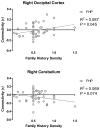Resting state functional connectivity of the nucleus accumbens in youth with a family history of alcoholism
- PMID: 24440571
- PMCID: PMC3943736
- DOI: 10.1016/j.pscychresns.2013.12.004
Resting state functional connectivity of the nucleus accumbens in youth with a family history of alcoholism
Abstract
Adolescents with a family history of alcoholism (FHP) are at heightened risk for developing alcohol use disorders (AUDs). The nucleus accumbens (NAcc), a key brain region for reward processing, is implicated in the development of AUDs. Thus, functional connectivity of the NAcc may be an important marker of risk in FHP youth. Resting state functional magnetic resonance imaging (rs-fcMRI) was used to examine the intrinsic connectivity of the NAcc in 47 FHP and 50 family history negative (FHN) youth, ages 10-16 years old. FHP and FHN adolescents showed significant group differences in resting state synchrony between the left NAcc and bilateral inferior frontal gyri and the left postcentral gyrus (PG). Additionally, FHP youth differed from FHN youth in right NAcc functional connectivity with the left orbitofrontal cortex (OFC), left superior temporal gyrus, right cerebellum, left PG, and right occipital cortex. These results indicate that FHP youth have less segregation between the NAcc and executive functioning brain regions, and less integration with reward-related brain areas, such as the OFC. The findings of the current study highlight that premorbid atypical connectivity of appetitive systems, in the absence of heavy alcohol use, may be a risk marker in FHP adolescents.
Keywords: Adolescence; Alcohol; Familial; Risk; Ventral striatum.
Copyright © 2013 Elsevier Ireland Ltd. All rights reserved.
Figures




References
-
- Alaux-Cantin S, Warnault V, Legastelois R, Botia B, Pierrefiche O, Vilpoux C, Naassila M. Alcohol intoxications during adolescence increase motivation for alcohol in adult rats and induce neuroadaptations in the nucleus accumbens. Neuropharmacology. 2013;67:521–531. - PubMed
-
- Andrews MM, Meda SA, Thomas AD, Potenza MN, Krystal JH, Worhunsky P, Stevens MC, O’Malley S, Book GA, Reynolds B, Pearlson GD. Individuals family history positive for alcoholism show functional magnetic resonance imaging differences in reward sensitivity that are related to impulsivity factors. Biological Psychiatry. 2011;69:675–683. - PMC - PubMed
-
- Bechara A, Dolan S, Denburg N, Hindes A, Anderson SW, Nathan PE. Decision-making deficits, linked to a dysfunctional ventromedial prefrontal cortex, revealed in alcohol and stimulant abusers. Neuropsychologia. 2001;39:376–389. - PubMed
-
- Beck A, Schlagenhauf F, Wustenberg T, Hein J, Kienast T, Kahnt T, Schmack K, Hagele C, Knutson B, Heinz A, Wrase J. Ventral striatal activation during reward anticipation correlates with impulsivity in alcoholics. Biological Psychiatry. 2009;66:734–742. - PubMed
Publication types
MeSH terms
Grants and funding
LinkOut - more resources
Full Text Sources
Other Literature Sources
Medical

